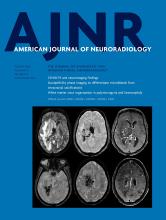Research ArticleInterventional
Dural Venous Channels: Hidden in Plain Sight–Reassessment of an Under-Recognized Entity
M. Shapiro, K. Srivatanakul, E. Raz, M. Litao, E. Nossek and P.K. Nelson
American Journal of Neuroradiology August 2020, 41 (8) 1434-1440; DOI: https://doi.org/10.3174/ajnr.A6647
M. Shapiro
aFrom the Departments of Radiology (M.S., E.R., P.K.N.)
bNeurology (M.S., M.L.)
K. Srivatanakul
dDepartment of Neurosurgery (K.S.), Tokai University, Kanagawa, Japan.
E. Raz
aFrom the Departments of Radiology (M.S., E.R., P.K.N.)
M. Litao
bNeurology (M.S., M.L.)
E. Nossek
cNeurosurgery (E.N., P.K.N.), NYU School of Medicine, New York, New York
P.K. Nelson
aFrom the Departments of Radiology (M.S., E.R., P.K.N.)
cNeurosurgery (E.N., P.K.N.), NYU School of Medicine, New York, New York

References
- 1.↵
- Lasjaunias PL,
- Berenstein A,
- terBrugge KG
- 2.↵
- 3.↵
- 4.↵
- Padget DH
- 5.↵
- Okudera T,
- Huang YP,
- Ohta T, et al
- 6.↵
- Maxeiner H
- 7.↵
- 8.↵
- 9.↵
- 10.↵
- Muthukumar N,
- Palaniappan P
- 11.↵
- 12.↵
- Byrne JV,
- Garcia M
- 13.↵
- 14.↵
- 15.↵
- Borden JA,
- Wu JK,
- Shucart WA
- 16.↵
- Cognard C,
- Gobin YP,
- Pierot L, et al
- 17.↵
- Kapp JP,
- Schmidek HH
- Huang YP,
- Okudera T,
- Ohta T, et al
- 18.↵
- Srivatanakul K,
- Songsaeng D,
- Salliou G
- 19.↵
In this issue
American Journal of Neuroradiology
Vol. 41, Issue 8
1 Aug 2020
Advertisement
M. Shapiro, K. Srivatanakul, E. Raz, M. Litao, E. Nossek, P.K. Nelson
Dural Venous Channels: Hidden in Plain Sight–Reassessment of an Under-Recognized Entity
American Journal of Neuroradiology Aug 2020, 41 (8) 1434-1440; DOI: 10.3174/ajnr.A6647
0 Responses
Jump to section
Related Articles
Cited By...
- Principles, techniques and applications of high resolution cone beam CT angiography in the neuroangio suite
- Cerebral venous anatomy: implications for the neurointerventionalist
- Cerebral venous anatomy: implications for the neurointerventionalist
- Principles, techniques and applications of high resolution cone beam CT angiography in the neuroangio suite
- The So-Called Cranial Dural Channels and Their Relationship with the Bridging Veins
This article has not yet been cited by articles in journals that are participating in Crossref Cited-by Linking.
More in this TOC Section
Similar Articles
Advertisement











